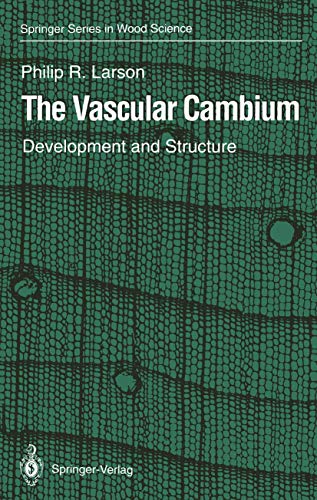Articoli correlati a The Vascular Cambium: Development and Structure

Le informazioni nella sezione "Riassunto" possono far riferimento a edizioni diverse di questo titolo.
Le informazioni nella sezione "Su questo libro" possono far riferimento a edizioni diverse di questo titolo.
- EditoreSpringer-Verlag
- Data di pubblicazione1994
- ISBN 10 3642784682
- ISBN 13 9783642784682
- RilegaturaCopertina flessibile
- Numero di pagine748
Compra nuovo
Scopri di più su questo articolo
Spese di spedizione:
EUR 23,00
Da: Germania a: U.S.A.
I migliori risultati di ricerca su AbeBooks
The Vascular Cambium
Descrizione libro Taschenbuch. Condizione: Neu. This item is printed on demand - it takes 3-4 days longer - Neuware -The cambium has been variously defined as follows: 'The actively dividing layer of cells that lies between, and gives rise to, secondary xylem and phloem (vascular cambium)' (IAWA 1964); 'A meristem with products of periclinal divisions commonly contributed in two directions and arranged in radial files. Term pre ferably applied only to the two lateral meristems, the vascular cambium and cork cambium, or phellogen' (Esau 1977); and, 'Lateral meristem in vascular plants which produces secondary xylem, secondary phloem, and parenchyma, usually in radial rows; it consists of one layer of initials and their undifferentiated deriva tives' (Little and Jones 1980). Clearly, the cambium is a diverse and extensive meristem, and no one defini tion will encompass all manifestations of what anatomists consider cambium. Its diversity and extent are further exemplified by a single plant, such as a temperate zone tree, in which procambium is initiated in the embryo and perpetuated throughout every lateral, primary meristem before giving rise to cambium in the secondary body. The cambium thereafter performs its meristematic task of producing daughter cells that differentiate to specialized tissue systems. The cam bium, however, does not remain static. Its derivatives vary either in form, or TImc tion, or rate of production at different positions on the tree, with age of the tree, and with season of the year. Moreover, the cambium responds both to internal sig nals and to external stimuli such as environment or wounding. 748 pp. Englisch. Codice articolo 9783642784682
The Vascular Cambium: Development and Structure (Springer Series in Wood Science)
Descrizione libro Condizione: New. Book is in NEW condition. Codice articolo 3642784682-2-1
The Vascular Cambium: Development and Structure (Springer Series in Wood Science)
Descrizione libro Condizione: New. New! This book is in the same immaculate condition as when it was published. Codice articolo 353-3642784682-new
The Vascular Cambium: Development and Structure (Springer Series in Wood Science) by Larson, Philip R. [Paperback ]
Descrizione libro Soft Cover. Condizione: new. Codice articolo 9783642784682
The Vascular Cambium : Development and Structure
Print on DemandDescrizione libro Condizione: New. PRINT ON DEMAND Book; New; Fast Shipping from the UK. No. book. Codice articolo ria9783642784682_lsuk
The Vascular Cambium: Development and Structure (Springer Series in Wood Science)
Descrizione libro Condizione: New. Codice articolo ABLIING23Mar3113020236324
The Vascular Cambium : Development and Structure
Descrizione libro Taschenbuch. Condizione: Neu. Druck auf Anfrage Neuware - Printed after ordering - The cambium has been variously defined as follows: 'The actively dividing layer of cells that lies between, and gives rise to, secondary xylem and phloem (vascular cambium)' (IAWA 1964); 'A meristem with products of periclinal divisions commonly contributed in two directions and arranged in radial files. Term pre ferably applied only to the two lateral meristems, the vascular cambium and cork cambium, or phellogen' (Esau 1977); and, 'Lateral meristem in vascular plants which produces secondary xylem, secondary phloem, and parenchyma, usually in radial rows; it consists of one layer of initials and their undifferentiated deriva tives' (Little and Jones 1980). Clearly, the cambium is a diverse and extensive meristem, and no one defini tion will encompass all manifestations of what anatomists consider cambium. Its diversity and extent are further exemplified by a single plant, such as a temperate zone tree, in which procambium is initiated in the embryo and perpetuated throughout every lateral, primary meristem before giving rise to cambium in the secondary body. The cambium thereafter performs its meristematic task of producing daughter cells that differentiate to specialized tissue systems. The cam bium, however, does not remain static. Its derivatives vary either in form, or TImc tion, or rate of production at different positions on the tree, with age of the tree, and with season of the year. Moreover, the cambium responds both to internal sig nals and to external stimuli such as environment or wounding. Codice articolo 9783642784682
The Vascular Cambium
Descrizione libro Condizione: New. Dieser Artikel ist ein Print on Demand Artikel und wird nach Ihrer Bestellung fuer Sie gedruckt. The cambium has been variously defined as follows: The actively dividing layer of cells that lies between, and gives rise to, secondary xylem and phloem (vascular cambium) (IAWA 1964) A meristem with products of periclinal divisions commonly contributed. Codice articolo 5070572
The Vascular Cambium
Descrizione libro Condizione: New. pp. 748. Codice articolo 2658569694
The Vascular Cambium: Development and Structure (Springer Series in Wood Science)
Descrizione libro Condizione: New. Codice articolo I-9783642784682

